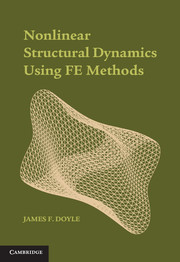Book contents
4 - Modeling Applied Loads
from PART I - MECHANICS AND MODELS
Published online by Cambridge University Press: 05 October 2014
Summary
Our method of choice for solving general problems is the finite-element (FE) method. The drawback of the method is that it does not directly give insights into the phenomena being studied. To help overcome this, Part II introduces additional analysis methods. The choice of analysis depends on the type of problem being considered; therefore, this chapter is an attempt to classify the problem types encountered in structural dynamics so as to set the context for the types of analyses introduced. We find it most useful to use the loading (both its variation in time and its variation in space over time) as the main discriminator between the different problem types and introduce appropriate analysis methods accordingly. In broad terms, we distinguish between low-frequency loads that cause large deformations and higher-frequency loads that cause nonlinear responses but no significant change of geometry. This facilitate using the linearized versions of problems as a scheme to classify them.
We begin by surveying an array of problems based on the types of loading. What they have in common is that there are interactions between one or more bodies. How these interactions are modeled, to a large extent, dictates the type of problem that results. This is followed by an analysis of conservative loads, and it is shown how these can be treated as part of the system.
- Type
- Chapter
- Information
- Nonlinear Structural Dynamics Using FE Methods , pp. 206 - 270Publisher: Cambridge University PressPrint publication year: 2014



